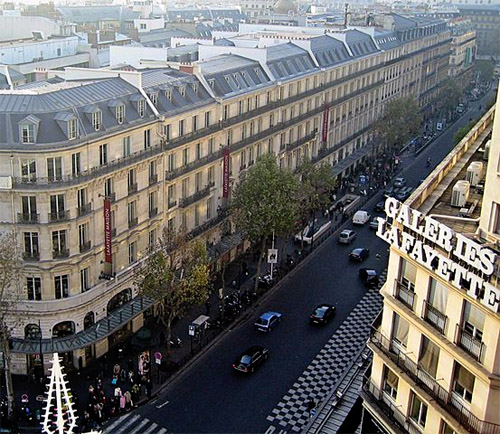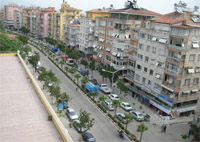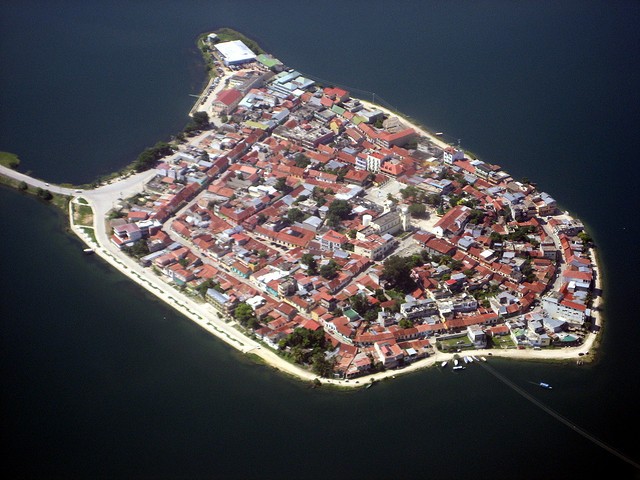I’m on vacation in Europe until the 24th. Each weekday until my return there will be a brief post about some feature of the city I’m visiting that day.
Without a doubt, Paris is home to the world’s most successful urban renewal scheme. The Haussmann Plan was carried out primarily between 1853 and 1870, and significantly contributed to the creation of Paris’ most famous boulevards and its iconic architectural style.
Under the guidance of city planner Baron Georges-Eugène Haussmann, large sections of Paris were demolished and rebuilt along wider, grander, straighter boulevards. And new building regulations were adopted that delineated the height and form of buildings.

Boulevard Haussmann, with its strictly regulated buildings.
Photo by Thierry Bézecourt via Wikepedia.
Average Rating: 4.9 out of 5 based on 198 user reviews.
March 19th, 2014 | Permalink
Tags: architecture, history, History of cities, urbandesign
Interesting fact of the day: Jericho, in the Palastinian-administered West Bank of Israel, is generally considered to be the oldest city in the world. It was founded sometime around 9000 bce, making it upwards of 11, 000 years old.
It’s more than 6, 000 years older than the oldest Egyptian pyramids. It predates Sumer, the first of the world’s great civilizations, by 4, 500 years. It was more ancient to the Romans than the Romans are to us, by far.
It’s been sacked, conquered, and abandoned at various times throughout history, but people always come back.
Suddenly, DC’s Victorian rowhouses seem a little less impressive.

Jericho. Photo by gashwin on flickr.
Average Rating: 4.5 out of 5 based on 259 user reviews.
September 17th, 2013 | Permalink
Tags: History of cities
|

Modern Antakya. Image from Asaf Aynur. |
Last year BeyondDC ran a story about Tayasal, a Mayan city that survived until almost 1700. Obviously the story had nothing to do with urbanism in Washington, DC; it was just a tidbit of urban history that I found fascinating. I said more such stories would appear from time to time, under the History of Cities tag. Here’s number 2.
Antioch was at its height the second largest city of the Roman Empire, after Rome itself. It may have had a population of up to 600, 000, and was the chief metropolis of the Near East for centuries, through the late ancient world and into the early middle ages.
I’ve always been curious about Antioch. Why didn’t it survive into the modern era, as its peers Rome, Alexandria, Constantinople, and Damascus did? There is a modern city on the same site in today’s Turkey, Antakya, but it is a totally different place, and its modern population of 200, 000 is a fraction of its ancient size.
Antioch survived the fall of Rome and remained an important city under the Byzantine Empire into the Crusader Era, before finally being abandoned around 1400. Its long decline lasted almost 1, 000 years, and probably began with the silting of its port around 500 CE. The city was on the front line of the wars between Christianity and Islam, and changed hands multiple times over hundreds of years. It finally died after the Mongol Empire’s invasion resulted in a dramatic depression of Middle Eastern civilization in general, and the end of the Islamic Golden Age.
Average Rating: 4.7 out of 5 based on 165 user reviews.
January 23rd, 2012 | Permalink
Tags: History of cities
If you’re reading BeyondDC the odds are good you’re interested in cities. As the writer of BeyondDC I certainly am interested in them. Occasionally I run across interesting pictures or facts about a city that may not be related to contemporary Washington, DC in any way, but that I nonetheless find to be fascinating. Consider this post the first in what will become an occasional series of short pieces on the history of cities.
Flores is an island city and regional capital located in northern Guatemala. There are about 14, 000 people living there today. Internet imagery shows the town to be an idyllic Mediterranean lookalike popular with tourists, featuring tight streets, bright colors, and warm water. Although current events unfortunately reveals it to be more dangerous, it’s a fascinating town unlike anything in the United States.
And yet the town today is not nearly as interesting as its glorious history. For hundreds of years it was called Tayasal, and it was here that the great Mayan civilization made its last stand. Although the largest Mayan cities collapsed before the arrival of Europeans, several large and powerful ones remained for centuries after. Tayasal was the longest-lived such city. It didn’t fall until 1697, almost 70 years after the Spanish started trying to capture it, and at least 156 years after they first came to the city peacefully. As an independent entity Tayasal outlived the Aztec Empire, the Incan Empire, and all the other great cities of the western hemisphere civilizations. It was here that the history of the world changed forever.
It’s one of ten thousand places I want to visit in my lifetime, but probably never will.
Average Rating: 4.7 out of 5 based on 156 user reviews.
June 23rd, 2011 | Permalink
Tags: History of cities

















